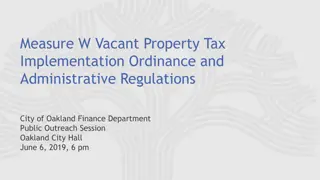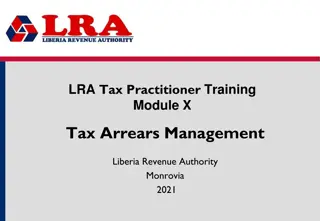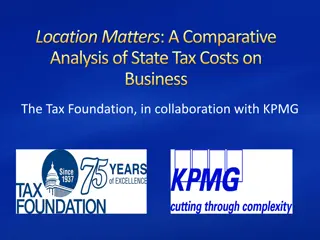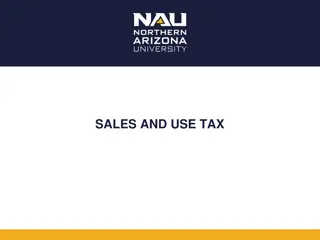Key Finance & Tax Aspects for Startups
the essential finance and tax considerations for startups, including definitions, tax exemptions, DPIIT registration process, and required documents.
Download Presentation

Please find below an Image/Link to download the presentation.
The content on the website is provided AS IS for your information and personal use only. It may not be sold, licensed, or shared on other websites without obtaining consent from the author.If you encounter any issues during the download, it is possible that the publisher has removed the file from their server.
You are allowed to download the files provided on this website for personal or commercial use, subject to the condition that they are used lawfully. All files are the property of their respective owners.
The content on the website is provided AS IS for your information and personal use only. It may not be sold, licensed, or shared on other websites without obtaining consent from the author.
E N D
Presentation Transcript
Important Aspects of Finance & Tax in Startups By: CA. Kalpesh P. Parekh FCA, CS, B.com
Definition of Startup: An entity shall be considered as a Startup: i. Up to a period of ten years from the date of incorporation/ registration, if it is incorporated as a private limited company (as defined in the Companies Act, 2013) or registered as a partnership firm (registered under section 59 of the Partnership Act, 1932) or a limited liability partnership (under the Limited Liability Partnership Act, 2008) in India. ii. Turnover of the entity for any of the financial years since incorporation/ registration has not exceeded one hundred crore rupees. iii. Entity is working towards innovation, development or improvement of products or processes or services, or if it is a scalable business model with a high potential of employment generation or wealth creation. Provided that an entity formed by splitting up or reconstruction of an existing business shall not be considered a Startup .
Various Tax Exemptions available for Startups: DPIIT Recognition Form 2 Declaration Section 80-IAC Certification
Documents required for DPIIT Registration Process: All Director s Aadhar, PAN, Email id and Contact no. Company s official website, link, or pitch deck if any Details about patent and trademark if any Intellectual Property Assignment Agreements if Any Founder/ Co-Founder Agreement if any Company s logo (Mandatory) Company s Mail id MOA, AOA and COI of company PAN Card of the company Company Details (Industry, Sector, Category, Regd. Office address etc.) A brief about business and products/services and notes on innovation Revenue model and uniqueness of products
DPIIT Registration Process: If after application it seems okay to the department then they will issue exemption. Select Apply Now in tab of Recognition Form from various available forms DPIIT Login Dashboard Click on DPIIT Recognition startupindia.gov.in
Form 2 Declaration Process: The Finance Act, 2012 has inserted the new Section 56(2)(viib) : Where a company, not being a company in which the public are substantially interested, receives, in any previous year, from any person, any consideration for issue of shares that exceeds the face value of such shares, the aggregate consideration received for such shares as exceeds the fair market value of the shares than consideration to the extent exceeding fair market value shall be chargeable to tax under the head Income From Other Source. Later on with the amendment inserted via Finance Act, 2023 brings into account the consideration received from non-resident under the ambit of section 56(2)(viib). The Ministry of Finance has allowed exemption to startups in order to provide relief from Angel Tax subject to fulfilment of following condition: - It should be DIPP recognized startup and - The amount of Paid-up share capital and security premium after the proposed issue should not exceed INR. 25 Crore.
Form 2 Declaration Process: - The startup has not invested in any of the following assets: (a) building or land appurtenant thereto, being a residential house, other than that used by the Startup for the purposes of renting or held by it as stock-in-trade, in the ordinary course of business; (b) land or building, or both, not being a residential house, other than that occupied by the Startup for its business or used by it for purposes of renting or held by it as stock-in trade, in the ordinary course of business; (c) loans and advances, other than loans or advances extended in the ordinary course of business by the Startup where the lending of money is substantial part of its business; (d) capital contribution made to any other entity; (e) shares and securities;
Form 2 Declaration Process: (f) a motor vehicle, aircraft, yacht or any other mode of transport, the actual cost of which exceeds ten lakh rupees, other than that held by the Startup for the purpose of plying, hiring, leasing or as stock-in-trade, in the ordinary course of business; (g) jewelry other than that held by the Startup as stock-in-trade in the ordinary course of business; (h) any other asset, whether in the nature of capital asset or otherwise, of the nature specified in sub-clauses (iv) to (ix) of clause (d) of Explanation to clause (vii) of sub-section (2) of section 56 of the Act.
Form 2 Declaration Process: Select Apply Now in tab of Form 56 from various available forms If after application it seems okay to the department then they will issue exemption. DPIIT Login Dashboard Click on DPIIT Recognition
Section 80-IAC Exemption Certification Eligibility: Objective: Section 80-IAC provides an incentive to start-ups in order to aid their growth in the early phase of their business Quantum of deduction: Accordingly, a deduction of the profits and gains derived by an eligible start-up from an eligible business is allowed for three consecutive assessment years out of ten years beginning from the year in which the eligible start up is incorporated.
Section 80-IAC Exemption Certification Eligibility: Meaning of eligible business: A business carried out by an eligible start-up engaged in - Innovation, development or improvement of products or processes or services or - a scalable business model with a high potential of employment generation or wealth creation Conditions to be fulfilled: A. It is not formed by splitting up, or the reconstruction, of a business already in existence. Exception: However, this condition shall not apply in the case of an undertaking which is formed as a result of reconstruction, re-establishment or revival of the business of any undertaking which has been discontinued in any previous year due to extensive damage or destruction of any building, machinery, plant or furniture owned by the assessee and used for the purposes of such business. Further, the reason for damage or destruction is due to any natural calamity or other unforeseen circumstances such three consecutive assessment years out of ten as the following: (i) Flood, typhoon, hurricane, cyclone, earthquake or Other natural calamity, or
Section 80-IAC Exemption Certification Eligibility: (ii) riot or civil disturbance, or (iii) accidental fire or explosion, or (iv) enemy action or action taken in combat, and such business is re-established or revived within 3 years from the end of such previous year. B. It is not formed by the transfer to a new business of machinery or plant previously used for any purpose. Exceptions: However, any machinery or plant which was used outside India by any person other than the assessee shall not be regarded as machinery or plant previously used for any purpose, if all the following conditions are fulfilled, namely: (a) such machinery or plant was not, at any time previous to the date of the installation by the assessee, used in India;
Section 80-IAC Exemption Certification Eligibility: (b) such machinery or plant is imported into India; (c) no deduction on account of depreciation in respect of such machinery or plant has been allowed or is allowable under the provisions of the Income-tax Act, 1961 in computing the total income of any person for any period prior to the date of the installation of the machinery or plant by the assessee. IMPORTANT : The companies which are incorporated after Oct 1, 2019 and have started their manufacturing operations on or before March 31, 2023 and have opted for Section 115BAB are not eligible to claim exemption under this section.
Section 80-IAC Exemption Certification Eligibility: Select Apply Now in tab of Form 80IAC from various available forms If after application it seems okay to the department then they will issue exemption. DPIIT Login Dashboard Click on DPIIT Recognition
Section 80-IAC Exemption Certification Eligibility: - Guidelines for Pitch deck and Video - Sample Video and Sample Pitch deck
Valuation of Startup: A valuation can be defined as the process of estimating the fair market value or the intrinsic value of a company. After analyzing the market value (the price at which a stock can be readily bought or sold in the current market place) and the intrinsic value (actual value of the stock based on its perceived true value), one can decide whether to buy, sell or hold a company s stock. If for a company: - The market value is greater than the intrinsic value, one should sell - The intrinsic value is greater than the market value, one should buy It must be noted that all valuations, regardless of the method in use, have certain principles: - Valuation is time specific. The value of a business changes everyday and depends on various factors such as the cash flow, earnings, working capital which are always in a state of flux - Value depends on future cash flows. These are primarily done by calculating the present value of these future cash flows
Valuation of Startup: - Certain market forces dictate the rate of return which is used to calculate the present value. These include the types of purchasers and general economic conditions - Liquidity affects the value of a company. With the increase in the liquidity of a company, its value increases as well since these liquid assets act as a security for the stockholders in case of a bankruptcy - Value is affected by underlying assets. This is primarily because with the increase in net assets, the likelihood of a company defaulting decreases since the liquidity is higher
Methods of Valuation: There are 2 main methods of valuation. Relative Valuations Models: Such models do not estimate the exact value of the stock but instead compare a particular company with other companies or a benchmark with the help of ratios like the Price-Earnings Ratio (P/E). Absolute Valuation Models: In these models, the value of an asset is estimated keeping in mind just the characteristics of that particular asset and not comparable assets which are trading in the marketplace at that point of time. Following are the various methods covered under this topic. - Discounted Cash Flow Model - Free Cash Flow Model - Discounted Dividend Model - Capital Asset Pricing Model
Methods of Valuation: Discounted Cash Flow Models: - It is a present value of predicted future cash flows. - It is the weighted average of future cash flows. - Arrived at using Weighted Average Cost of Capital (WACC) (also known as discounting rate) - Ultimately used to know the NPV of the project.
Example of Discounted Cash Flow Method: Question:
Methods of Valuation: Free Cash Flow - This method is similar to the Simple Payback period method that how much time an initial project cost took to recover the same. - Works on the basis of simple average of projected cash flows. - One of the drawbacks of the model is that the valuation is only as good as the inputs which may be biased in nature and a small change in these inputs can make a large difference to the end value that the model arrives at. - Cash Flows are arrived at using following formula. Free Cash Flow = Cash Flow from Operations-(Total Capital Expenditure-After Tax proceeds from sale of assets)
Methods of Valuation: Discounted Dividend Models: - Based on the assumption that only shareholders are entitled to dividends. - In this method share price are considered as cash outflow and dividends are considered as cash inflow. - Firm uses Discount Rate (WACC) to arrive at present value of shares. - Following formula is used for valuation as per this model. Value of Stock= Dividend per Share / (Discount Rate (Ke) Dividend Growth Rate(g)) - However this model can t be applied for firms that don t pay out dividends
Methods of Valuation: Capital Asset Pricing Model: The CAPM Model gives us a relationship between risk and expected return for stocks. The model is used for the pricing of risky securities, estimating returns etc. The investment of a shareholder, according to the model, must be compensated in a dual manner: risk and time value of money. The investors take an additional risk and hence must get a return which is higher than the risk free rate. This higher return is given by the risk premium which is an amount of market return higher than the risk free rate. Re = Rf + Ba*(Rm-Rf) Where: Re: This signifies the Expected Return of a capital asset over time. It is a long term assumption to estimate how an investment will behave over its entire life span. Rf: This signifies the Risk-free Rate (minimum return that an investor expects) and can be calculated by observing government or treasury bonds. Ba: This signifies Beta of the security which is a measure of the stock s volatility and is reflected by measuring the fluctuation of its price changes relative to that of the market. Rm-Rf: This signifies the risk premium that an investor should get for taking an additional risk due to the volatile nature of the investment.
What is financial modeling?: Financial modeling is the task of building an abstract representation (a model) of a real world financial situation. This is a mathematical model designed to represent (a simplified version of) the performance of a financial asset or portfolio of a business, project, or any other investment. Typically, then, financial modeling is understood to mean an exercise in either asset pricing or corporate finance, of a quantitative nature. It is about translating a set of hypotheses about the behavior of markets or agents into numerical predictions. At the same time, "financial modeling" is a general term that means different things to different users; the reference usually relates either to accounting and corporate finance applications or to quantitative finance applications.
What is financial modeling?: The application of financial modeling includes . -Business valuation and stock valuation - especially via discounted cash flow, but including other valuation approaches -Scenario planning and management decision making ("what is"; "what if"; "what has to be done") -Budgeting: revenue forecasting and analytics; production budgeting; operations budgeting -Capital budgeting, including cost of capital (i.e. WACC) calculations -Cash flow forecasting; working capital- and treasury management; asset and liability management -Financial statement analysis / ratio analysis (including of operating- and finance leases, and R&D) -Transaction analytics: M&A, PE, VC, LBO, IPO, Project finance, P3
What is financial modeling?: The application of financial modeling includes . -Credit decisioning: Credit analysis, Consumer credit risk; impairment- and provision- modeling -Management accounting: Activity-based costing, Profitability analysis, Cost analysis, Whole-life cost, Managerial risk accounting -Modeling the term structure of interest rates (bootstrapping / multi-curves, short-rate models, HJM framework) and any related credit spread -Credit valuation adjustment, CVA, as well as the various XVA -Credit risk, counterparty credit risk, and regulatory capital: EAD, PD, LGD, PFE, EE; Jarrow Turnbull model, Merton model, KMV model -Structured product design and manufacture
MIS Report in Startup: MIS Statements With increasing complexity in businesses and technological advances, evaluating organizational performance has become crucial. As Managements we rely on extensive reporting of every aspect of our business to help with efficient management. Such reports provide deep insights for making smart business decisions and strategies. Management Information System, which is integrated with accounting software, is the full form of a MIS report. It offers a wide range of reports on trends, inventories, cash flows, and other topics to encourage the use of automation in management information systems, allowing businesses to run more efficiently and productively. MIS Statements can be prepared monthly, quarterly, semi-annually or annually as per the investors or board of director s requirements.
MIS Report in Startup: Basic things you need to consider while preparing the MIS Report. - Make sure the numbers are directly derived by the immediate manager. - Formulas should be correctly put. - Should be simple but informative - Show comparisons in every month. - Consistency (e.g. if amounts are in Cr or Lacs it should be the same overall) - It should show a story or a chain
MIS Report in Startup: So Mainly MIS Statements are made of 4 important components: A CFO Dashboard is basically a glimpse of current month s performance in comparison to previous months. Revenue & EBIDTA are the main constraints which are similar in every business. Hence, they remain fixed. Components in the CFO Dashboard varies according to the industry. For e.g. In an healthcare industry occupancy of Beds, number of patients etc. are tracked whereas in an hospitality business the revenue incurred from the various franchises, the number of orders from dine in or takeaway are measured. The dashboard shows the significant increase/decrease of these components between the current month and the previous month.
MIS Report in Startup: Secondly, Industry ratios helps us tell a story of our performance which mere numbers can t. Key metrics help us compare our growth or downfall with the industrial performance. It gives precise percentages for better understanding. For e.g. EBITDA Ratios, Marginal Ratios, Revenue Growth, Increase/Decrease in Costs, Cost as a % of revenue etc. Some ratios are also industry specific for e.g. in the healthcare industry average revenue per patient, average cost per patient, marginal cost per bed etc. are measured. Budget Variances, simply put measures the difference between your budgeted performance with your actual performance. Budget variances helps you realize the actual performance or growth of your company in comparison to your budgeted figures and helps you to take effective measures as required. Lastly, Company Financials, it includes the Balance Sheet, Income & Expense sheet and Cash Flow statement.
Points to take care while preparing Pitch Deck: - Business Model should be defined precisely and accurately. - Entire Pitch deck should be product centric. - Requirements of the fund should be in parity with the actual projections from current scenario. - Income Statement Projections should be very descriptive and detailed. - Month wise Income Statement Projections & Year wise Income Statement Projections both should be given. - Projected Cash Flow of the business should be detailed also and both in month and year wise.
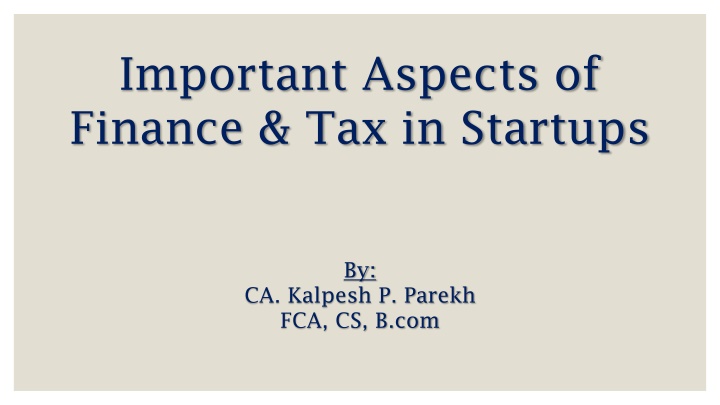


![Town of [Town Name] Real Estate Tax Rates and FY 2024 Budget Summary](/thumb/62211/town-of-town-name-real-estate-tax-rates-and-fy-2024-budget-summary.jpg)












